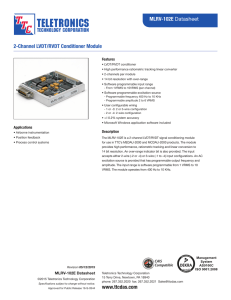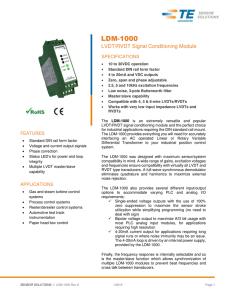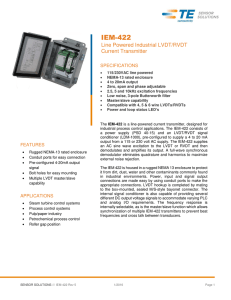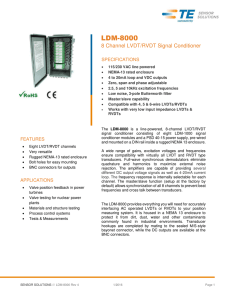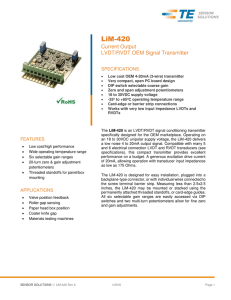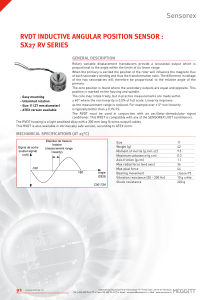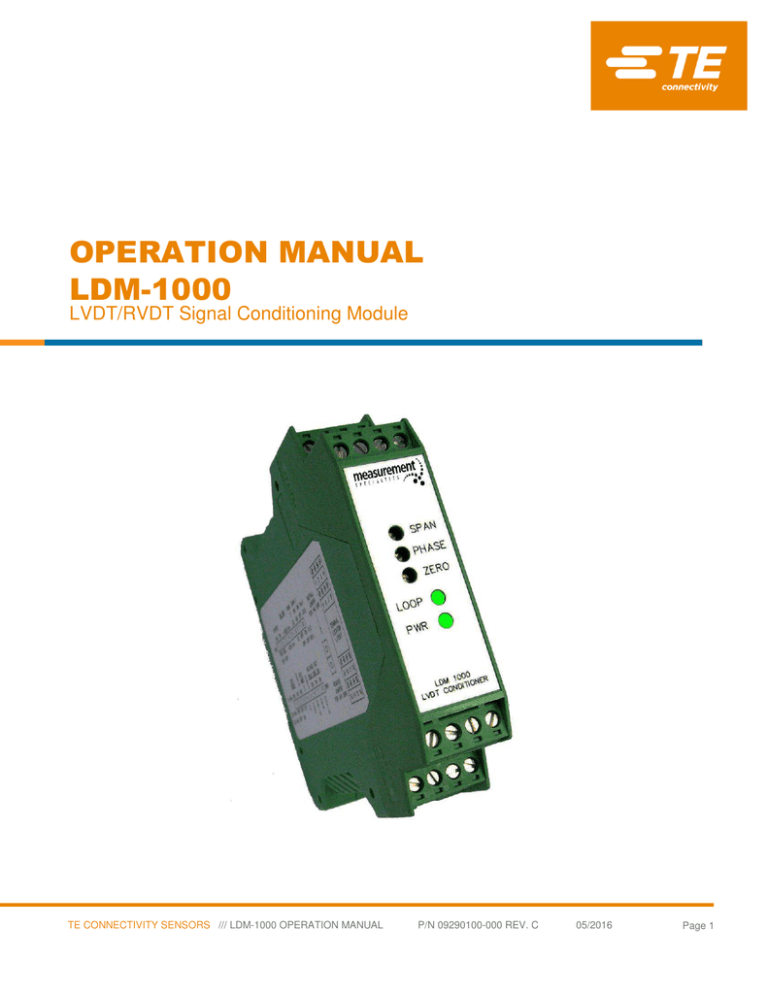
OPERATION MANUAL
LDM-1000
LVDT/RVDT Signal Conditioning Module
TE CONNECTIVITY SENSORS /// LDM-1000 OPERATION MANUAL
P/N 09290100-000 REV. C
05/2016
Page 1
LDM-1000
LVDT/RVDT Signal Conditioning Module
Table of Contents
1.
Introduction ......................................................................................................................................................3
2.
Product Specifications ....................................................................................................................................3
3.
Product Description .........................................................................................................................................4
4.
Initial Setup Procedure ....................................................................................................................................4
4. 1. Supply Voltage .............................................................................................................................................5
4. 2. Internal Switches ..........................................................................................................................................6
4. 3. Oscillator Frequency: ...................................................................................................................................6
4. 4. Oscillator ‘Sync’ Mode ..................................................................................................................................7
4. 5. Oscillator Drive Capability ............................................................................................................................7
4. 6. Setting the Amplifier Gain ............................................................................................................................7
5.
Dimensions and Wiring Terminals .................................................................................................................8
6.
Connection Diagrams ......................................................................................................................................9
7.
Calibration Procedure .................................................................................................................................. 10
TE CONNECTIVITY SENSORS /// LDM-1000 OPERATION MANUAL
P/N 09290100-000 REV. C
05/2016
Page 2
LDM-1000
LVDT/RVDT Signal Conditioning Module
1. Introduction
The LDM-1000 is an extremely versatile LVDT/RVDT (Linear or Rotary Variable Differential Transformer) signal conditioning
module. The module supplies an AC sine wave excitation to the LVDT or RVDT, and demodulates, filters, and amplifies the
output. It is the perfect choice for industrial applications requiring the DIN standard rail mount.
2. Product Specifications
For complete specifications and ordering information, please refer to the datasheet at:
http://www.te.com/usa-en/product-CAT-PSI0003.html
ELECTRICAL SPECIFICATIONS
Supply voltage
Supply current
Output types and ranges
Temp. coefficient of output
Voltage output noise/ripple
Current output noise/ripple
Current loop resistance
Frequency response
Non-linearity
Input sensitivity range
18 to 30VDC or 10 to 18VDC (jumper selectable, 18 to 30VDC as shipped)
65mA maximum
±5VDC, 0 to 5VDC, 0 to 10VDC, and 4~20mA (DIP switch selectable, ±5VDC as shipped)
±0.02% of FSO per °F [±0.036% of FSO per °C] over the operating temperature range
5mV RMS maximum
25µA RMS maximum
700Ω maximum (with 18 to 30VDC supply voltage)
250 or 1000Hz @ -3 dB (3-pole Butterworth, DIP switch selectable, 250Hz as shipped)
±0.02% of FSO
0.05 to 2.50 VRMS
Transducer excitation
1 or 3 VRMS (DIP switch selectable; 3VRMS as shipped, with 18 to 30VDC supply
voltage only)
25mA RMS
2.5, 5 or 10kHz (DIP switch selectable, 2.5kHz as shipped)
Voltage
Current
Frequency
Transducer requirements
Transducer type
LVDT/RVDT input impedance
LVDT/RVDT full scale output
LVDT or RVDT with 4, 5 or 6 electrical connections
50Ω minimum @ 1 VRMS excitation ; 150Ω minimum @ 3 VRMS
0.05 to 2.50 VRMS
ENVIRONMENTAL AND MECHANICAL SPECIFICATIONS
Operating temperature range
Storage temperature range
Mounting
Size
Wire terminal size
IEC 60529 rating
-13°F to +185°F [-25°C to +85°C]
-67°F to +257°F [-55°C to +125°C]
Standard DIN-3 rail mount
3.90 [99.0] high x 0.89 [22.5] wide x 4.51 [114.5] Deep
24 to 12 AWG [0.2 to 2.5mm]
IP60
Notes:
All values are nominal unless otherwise noted; dimensions are in inch [mm]
FSO (Full Scale Output) is the largest absolute value of the outputs measured at the range ends.
TE CONNECTIVITY SENSORS /// LDM-1000 OPERATION MANUAL
P/N 09290100-000 REV. C
05/2016
Page 3
LDM-1000
LVDT/RVDT Signal Conditioning Module
3. Product Description
DIP switches are provided to allow selection of three transducer excitation frequencies (2.5, 5 and 10 kHz), two signal bandwidths
(250 or 1,000 Hertz), and two excitation voltages (1 or 3 Volts RMS). Switches are also provided to select seven coarse gain
ranges, three DC output voltage ranges, two offsets, and master/slave operation. The 4 to 20mA output will operate regardless
of the DC output voltage dip switch settings.
Three multi-turn potentiometers located on the front panel allow precise gain (SPAN), offset (ZERO) and phase shift (PHASE)
adjustments.
An internal jumper allows changing the input voltage range from 18~30 VDC to 10~18 VDC.
A green LED on the front panel lights up when the LDM-1000 is powered on. A second green LED light indicates that the loop
current is flowing.
The LDM-1000 is designed to be mounted to a standard number 3 DIN rail. Input/output connections are made through plug-in
screw terminal barrier strips. These plug-in strips are keyed to prevent improper connections in the unlikely event that the LDM1000 should require field replacement.
The next few pages will take you, step by step, through the simple set-up and calibration process. This device may be set-up for
several different full scale analog outputs; some of the potential configurations are listed below:
±5 VDC output
0 to 5 VDC output
0 to 10 VDC output
4 to 20mA DC output
Standalone and Master/Slave operation
4. Initial Setup Procedure
To properly configure the LDM-1000 for the LVDT or RVDT you are using, you must access the internal dip switches. To open
the housing, depress the two latches with a screwdriver (see photos below); the housing will spring open. You can slide the front
panel and PC board assembly forward approximately 1.6 inch (4cm) to access the dip switches and input voltage jumper. A
spring stop prevents the PCB from being removed completely.
In order to begin the setup process, you must first know a few basic characteristics about the LVDT or RVDT you intend to use
with the LDM-1000. The information may be obtained from the transducer calibration sheet, catalog literature, or the TE web
site at: http://www.te.com/usa-en/products/sensors/position-sensors/linear-position-sensors-lvdt-lvit.html?tab=pgp-story
TE CONNECTIVITY SENSORS /// LDM-1000 OPERATION MANUAL
P/N 09290100-000 REV. C
05/2016
Page 4
LDM-1000
LVDT/RVDT Signal Conditioning Module
The list below is the minimum information required to perform a successful calibration:
Recommended LVDT or RVDT excitation frequency (to set the oscillator frequency)
LVDT or RVDT Output sensitivity at the excitation frequency (to set the gain)
Primary (input) impedance at the excitation frequency (to set the oscillator output voltage)
The ± full scale linear or angular range over which you intend to perform the calibration
Analog output signal required by your application
4. 1. Supply Voltage
The LDM-1000 supply voltage range is 18~30 VDC with the JP1 jumper in the storage position (as shipped position). Only this
range (18~30VDC) can be used for 4-20mA output operation. The operating voltage may be changed to 10~18 VDC by installing
internal jumper JP1 across both pins. See the diagrams below for jumper settings.
CAUTION: Operating the unit at voltages above +18 volts with the jumper in the low voltage position will overheat
the internal voltage regulators and reduce the operational life of the LDM-1000.
TE CONNECTIVITY SENSORS /// LDM-1000 OPERATION MANUAL
P/N 09290100-000 REV. C
05/2016
Page 5
LDM-1000
LVDT/RVDT Signal Conditioning Module
4. 2. Internal Switches
There are two internal DIP switch sets (SW1 and SW2) on the PC board assembly of the LDM-1000. The tables below explain
the switch positions and functions.
Switch Set SW1
Function:
Offset
Signal Bandwidth
3
4
Gain 2
Switch No:
1
2
5
6
Switch ON:
Positive
Negative
1 kHz
1 kHz
1 kHz
LOW
Switch OFF:
None
None
250 HZ
250 HZ
250 HZ
HIGH
Gain 1
7
Note: Switches 3, 4 & 5 must be
in same position
Note: The 1 kHz bandwidth setting is not recommended for excitation frequencies other than
10 kHz, otherwise significant noise will be present on the output signal.
8
Switch position
Gain
OFF
x0.4
OFF
OFF
ON
x1.2
ON
OFF
x3.63
ON
ON
x4.43
Switch Set SW2
Function:
Oscillator Frequency
Switch No:
1
Frequency
Sync
Osc. V
3
4
Switch ON:
INT
1 VRMS
Switch OFF:
EXT
3 VRMS
2
Switch Position
10 kHz
ON
ON
5 kHz
OFF
ON
2.5 kHz
OFF
OFF
Output Range VDC
5
6
7
8
0~5
±5
0~10
Only one switch ON
4 to 20mA output works
with any setting
Notes: Default factory settings are noted in BLUE in the above tables. Switch No. 5 of SW2 is not used. 3VRMS excitation is
available only with the 18~30VDC supply voltage setting.
4. 3. Oscillator Frequency:
Once you have established the proper excitation frequency for your transducer, refer to the tables below to set the oscillator.
For 2.5 KHz excitation (default factory setting):
Switch Set SW2
Function:
Switch Set SW1
Oscillator Frequency
Function:
Signal Bandwidth
Switch No:
1
2
Switch No:
3
4
5
2.5kHz
OFF
OFF
250 HZ
OFF
OFF
OFF
For 5 KHz excitation:
Switch Set SW2
Function:
Switch Set SW1
Oscillator Frequency
Function:
Signal Bandwidth
Switch No:
1
2
Switch No:
3
4
5
5kHz
OFF
ON
250 HZ
OFF
OFF
OFF
For 10 KHz excitation:
Switch Set SW2
Function:
Switch Set SW1
Oscillator Frequency
Function:
Signal Bandwidth
Switch No:
1
2
Switch No:
3
4
5
10 kHz
ON
ON
1 kHz
ON
ON
ON
TE CONNECTIVITY SENSORS /// LDM-1000 OPERATION MANUAL
P/N 09290100-000 REV. C
05/2016
Page 6
LDM-1000
LVDT/RVDT Signal Conditioning Module
4. 4. Oscillator ‘Sync’ Mode
The Oscillator ‘Sync’ mode setting will depend on the number of LDM-1000’s and transducers in your system, and their physical
locations. For a single LVDT or RVDT system you will be running the LDM-1000 in the Master (INT) mode. For systems with
multiple LDM-1000’s, especially when they are co-located, and/or the interconnect cables between the LDM-1000’s and the
transducers run identical paths, it is recommended to Master and Slave the LDM-1000 oscillators to prevent beat frequencies
and crosstalk between amplifiers and transducers. You will be selecting one LDM-1000 to serve as the Master oscillator (INT),
and the balance will be set-up in the Slave mode (EXT).
CAUTION: Attempting to synchronize two LDM-1000 set as masters (factory default setting) may damage one or both
units. Only one unit can be set to Master mode (INT, SW2 Switch 3 ON), otherwise damage to the electronics may result
(See connection diagrams). All other units must be in the Slave mode (EXT, SW2 Switch 3 OFF).
Connecting Pins 11 (Sync OUT) and 12 (Sync COM) of the barrier strip, from unit to unit, will complete the sync bus circuit (See
connection diagrams). The power common serves as the return line. Use the table below to configure your oscillator mode:
SW2-3
OFF
Mode
SLAVE
ON
MASTER
4. 5. Oscillator Drive Capability
To ensure LVDT/RVDT compatibility with the LDM-1000 you must know the transducer current draw. The LDM-1000 is designed
with a robust sine wave oscillator; it is rated for a maximum drive current of 25mA RMS with a voltage amplitude of 1 or 3 VRMS.
Therefore, you will need to know the LVDT/RVDT transducer input impedance for the frequency at which you intend to operate
it. With the (factory default) 3 VRMS oscillator voltage, the transducer input impedance must be equal to or greater than 120
Ohms, which will result in current draw of 25mA or less. If the impedance of the transducer is lower, the 1 VRMS setting must
be selected; with this setting, the LDM-1000 will be able to operate with impedances as low as 40 Ohms. The input impedance
information is available on the datasheets for all MEAS LVDTs and RVDTs.
4. 6. Setting the Amplifier Gain
You will need to calculate the LVDT or RVDT full scale output, using the simple formula below:
LVDT/RVDT sensitivity (in V/V/inch or V/V/degree), at the selected frequency, multiplied with
the excitation voltage, (1 or 3 VRMS for the LDM-1000), multiplied with
the full scale of the LVDT in inches (or RVDT in degrees).
As an example, the calculation for a MEAS HR1000 LVDT (±1 inch range; 1 inch full scale), with a sensitivity of 0.39V/V/inch at
2.5KHZ, with 3 VRMS excitation would be done as follows:
0.39 x 3 x 1 = 1.17 VRMS full scale output or 1.17 VRMS at ± 1 inch
Using the table below, select the gain settings (switch numbers 6, 7 and 8 of SW1) for the range your full scale output falls into.
In our example, you would use x0.4 HIGH.
Gain 1
Gain
x0.4
x0.4
x1.2
x1.2
x3.63
x3.63
x4.43
SW1-7
OFF
OFF
OFF
OFF
ON
ON
ON
Gain 2
SW1-8
OFF
OFF
ON
ON
OFF
OFF
ON
Gain Lo/Hi
LOW
HIGH
LOW
HIGH
LOW
HIGH
HIGH
TE CONNECTIVITY SENSORS /// LDM-1000 OPERATION MANUAL
SW1-6
ON
OFF
ON
OFF
ON
OFF
OFF
LVDT Full Scale
Output, VRMS
1.20 to 2.50
0.78 to 1.20
0.40 to 0.78
0.26 to 0.40
0.13 to 0.26
0.10 to 0.13
0.05 to 0.10
P/N 09290100-000 REV. C
05/2016
Page 7
LDM-1000
LVDT/RVDT Signal Conditioning Module
5. Dimensions and Wiring Terminals
TE CONNECTIVITY SENSORS /// LDM-1000 OPERATION MANUAL
P/N 09290100-000 REV. C
05/2016
Page 8
LDM-1000
LVDT/RVDT Signal Conditioning Module
6. Connection Diagrams
TE CONNECTIVITY SENSORS /// LDM-1000 OPERATION MANUAL
P/N 09290100-000 REV. C
05/2016
Page 9
LDM-1000
LVDT/RVDT Signal Conditioning Module
7. Calibration Procedure
Using the P1 and P2 terminal blocks according to the “Connection Diagrams” section of this manual, connect the LVDT or RVDT,
a DC voltmeter, and a power supply (see “Supply Voltage” under the “Initial Setup Procedure” section of this manual) to the
LDM-1000. Turn the power on and allow a 15 minute warm-up. Follow the procedure below:
1.
Disconnect the LVDT/RVDT primary wire from Terminal 1 of P1.
2.
Adjust the ZERO potentiometer on the front panel until:
the DC voltage output between terminals 9 (SIGNAL COM) and 10 (SIGNAL OUT), or
the DC current between terminals 15 (CURRENT COM) and 16 (CURRENT OUT)
reads in the middle of the range (see “Internal Switches” under the “Initial Setup Procedure” section of this manual for
output DC voltage range selection).
Note: The middle of the range is as follows:
2.
0.0 VDC mid-range reading for ± 5 VDC Output
2.5 VDC mid-range reading for 0 to +5 VDC output
5.0 VDC mid-range reading for 0 to +10 VDC output
12.0mA mid-range reading for 4 to 20mA output
Reconnect the LVDT/RVDT primary wire to Terminal 1 or P1. Insert the LVDT core into the middle of the bore, or rotate
the RVDT shaft to the approximate center of the mechanical range, until the output reads as close to the mid-range DC
voltage or current as possible (see mid-range readings in Step 2. above). If this adjustment is mechanically difficult or
impractical, approximate the correct position as closely as possible, and then adjust the ZERO potentiometer until the
output reads the middle of the range (see mid-range readings in Step 2. above).
Note: Changing course gain settings (DIP switches) after this step may result in a zero shift. Should you find it necessary
to change the gain, you should repeat steps 1 through 3.
3.
Displace the core of the LVDT or rotate the RVDT shaft in a positive direction (increasing DC voltage between terminals
9 and 10 or increasing DC current between 15 and 16) to approximately 80% of the full scale position you used in your
calculation in “Setting the Amplifier Gain”.
4.
Adjust the front panel PHASE potentiometer in the direction that increases the DC output signal until the maximum
output is reached; if the output does not peak and the PHASE potentiometer is at the end of its adjustment range, leave
it there and continue the calibration procedure.
Note: If during the phase adjustment the output exceeds the maximum limit of the selected range, reduce the output
back to a 70-80% level by adjusting the front panel SPAN potentiometer, then continue with the phase adjust operation.
5.
Return the LVDT core or the RVDT shaft back to the original center position. If the exact same mid-range DC output
as in Step 2 above is not observed, slightly re-adjust of the ZERO potentiometer.
6.
Using a precision positioning device, displace the LVDT core or rotate the RVDT shaft in a positive direction to the full
scale position used in your calculation.
Note: The calibration can be made over a percentage of full scale by moving the core xx% of full scale and adjusting
the output for the same percentage.
7.
Adjust the front panel SPAN potentiometer for the required positive full scale DC output (usually the maximum output
limit of the selected range, in Step 2 above).
Note: If the required full-scale reading cannot be obtained by adjusting the SPAN potentiometer, the gain of the signal
conditioner can be reset by changing the internal switches (see the “Setting the Amplifier Gain” section): If the SPAN
potentiometer is fully counter clockwise, change to the next higher gain. If the SPAN potentiometer is fully clockwise,
change to the next lower gain.
8. Return the LVDT core or the RVDT shaft back to the original center position and re-check the output reading (should
be the same mid-range reading as in Step 2 above). If needed, use the ZERO potentiometer to make a small
adjustment.
9.
Displace the LVDT core or rotate the RVDT shaft to the negative full scale position (lowest output DC voltage or current);
it should match the minimum reading for the range selected in Step 2 above. If needed, use the SPAN potentiometer
to make a small adjustment
Note: Due to symmetry errors of all LVDTs and RVDTs, the exact minimum and maximum output readings are rarely
obtained.
TE CONNECTIVITY SENSORS /// LDM-1000 OPERATION MANUAL
P/N 09290100-000 REV. C
05/2016
Page 10
LDM-1000
LVDT/RVDT Signal Conditioning Module
NORTH AMERICA
EUROPE
ASIA
Measurement Specialties, Inc.,
a TE Connectivity Company
1000 Lucas Way
Hampton, VA 23666
United States
Phone: +1-800-745-8008
Fax: +1-757-766-4297
Email: sales@meas-spec.com
MEAS Deutschland GmbH
a TE Connectivity Company
Hauert 13
D-44227 Dortmund
Germany
Phone: +49-(0)231-9740-0
Fax: +49-(0)231-9740-20
Email: info.de@meas-spec.com
Measurement Specialties China Ltd.,
a TE Connectivity Company
No. 26, Langshan Road
High-tech Park (North)
Nanshan District, Shenzhen 518057
China
Phone: +86-755-33305088
Fax: +86-755-33305099
Email: info.cn@meas-spec.com
TE.com/sensorsolutions
Measurement Specialties, Inc., a TE Connectivity company.
Measurement Specialties (MEAS), American Sensor Technologies (AST), TE Connectivity, TE Connectivity (logo) and EVERY CONNECTION COUNTS are trademarks. All other logos,
products and/or company names referred to herein might be trademarks of their respective owners.
The information given herein, including drawings, illustrations and schematics which are intended for illustration purposes only, is believed to be reliable. However, TE Connectivity makes
no warranties as to its accuracy or completeness and disclaims any liability in connection with its use. TE Connectivity‘s obligations shall only be as set forth in TE Connectivity‘s Standard
Terms and Conditions of Sale for this product and in no case will TE Connectivity be liable for any incidental, indirect or consequential damages arising out of the sale, resale, use or misuse
of the product. Users of TE Connectivity products should make their own evaluation to determine the suitability of each such product for the specific application.
© 2016
TE Connectivity Ltd. family of companies
All Rights Reserved.
TE CONNECTIVITY SENSORS /// LDM-1000 OPERATION MANUAL
P/N 09290100-000 REV. C
05/2016
Page 11

